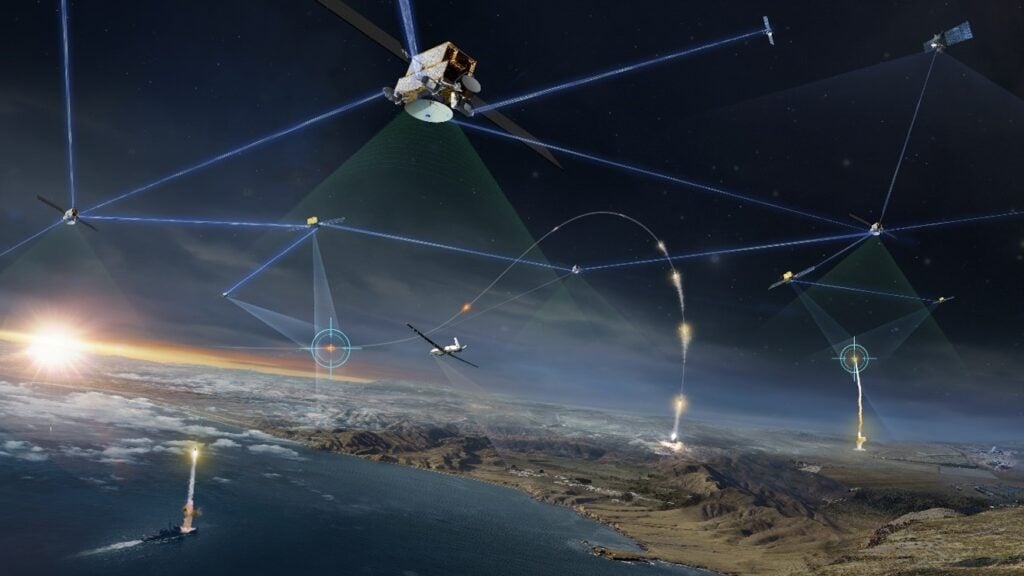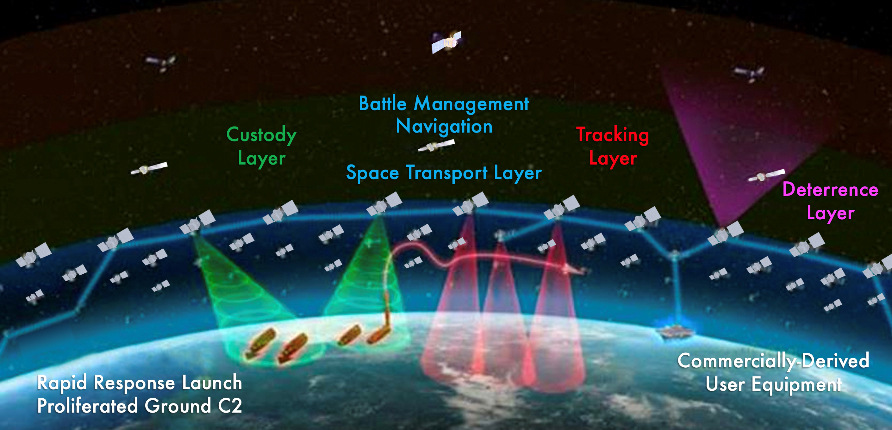
The Space Development Agency will begin launching its Tranche 1 Transport Layer communications mesh network in 2024. (Northrop Grumman)
WASHINGTON — Following its realignment underneath the Space Force, the Space Development Agency today changed the name of its multi-mission satellite network from the National Defense Space Architecture to the Proliferated Warfighter Space Architecture, but not its mission to rapidly launch ever-better payloads into low Earth orbit, says SDA Director Derek Tournear.
The agency’s “emphasis,” he told Breaking Defense, remains “on proliferated” constellations, with the agency continuing to work on orbiting hundreds of small, interlinked satellites that will be harder for adversaries to successfully target, as well as “on [the] warflighter” and getting capabilities into their hands as fast as possible.
The name change for SDAs seven-layer network of satellite and ground systems was approved by both Air Force Secretary Frank Kendall and space acquisition czar Frank Calvelli, and is designed to better reflect the network’s actual mission, Tournear said. It also was aimed at avoiding confusion given that there are a number of other Defense Department and Space Force satellite constellations in orbit and in development.
Not only does the Space Force’s major acquisition command, Space Systems Command, develop and launch satellites, so does the service’s Space Rapid Capabilities Office, as well as DoD’s Defense Innovation Unit, the Defense Advanced Research Projects Office, and the National Reconnaissance Office.
Along with the name change came an update in SDA’s launch plans, as Tournear said that despite delays in the two planned launches of its initial configuration of Tranche 0 satellites — pushing the first back from September 2022 to March 2023, and the second from March 2023 to June 2023 — the next iteration of data relay and missile warning/tracking birds, called Tranche 1, remains on schedule to start launch in September 2024.
“There’s 10 launches total and the launches are one month apart,” Tournear said. “It’s basically one-a-month starting in September 2024.”
Tranche 0 will comprise 28 satellites: 20 in the Transport Layer for communications and data; and eight in the missile warning/tracking Tracking Layer. These satellites are designed as a baseline, with the goal being able to work out the kinks in network configuration.
The agency in July 2020 awarded defense giant Lockheed Martin and relative newcomer York Space Systems contracts to each build a set of 10 satellites for the Tranche 0 Transport Layer birds: Lockheed Martin’s contract was worth $187.5 million; York’s, $94 million. In October 2020, it awarded SpaceX $149 million and L3Harris $194 million to each build four satellites for the agency’s Tracking Layer Tranche 0 designed to detect ballistic, cruise and hypersonic missiles.

The Space Development Agency’s multi-layer architecture for LEO satellites and ground stations. (SDA)
Tranche 1 will be the first mission capable constellation, consisting of 128 satellites in the Transport Layer, and 28 in the Tracking Layer, as well as 18 experimental satellites. SDA in February 2022 awarded $1.8 billion in contracts today to York Space Systems, Northrop Grumman and Lockheed Martin for development of the Transport Layer satellites. In July 2022, The agency tapped L3 Harris and Northrop Grumman to each build 14 Tracking Layer satellites, with L3 Harris’s award potentially worth some $700 million; and Northrop Grumman’s potentially worth about $617 million.
The agency’s ground system development effort for Tranche 1 also is “progressing exceptionally well,” Tournear said. SDA is developing two main networking and operations centers, one at the Army’s Redstone Arsenal in Alabama and the other at Grand Forks AFB in North Dakota. It also will stand up “on the order of a dozen” ground entry points around the globe, Tournear said, where data can be downlinked. SDA in May 2022 awarded a team led by General Dynamics and Iridium a contract worth $324.5 million for “ground operations and integration.”
HASC chair backs Air Force plan on space Guard units (Exclusive)
House Armed Services Chairman Mike Rogers tells Breaking Defense that Guard advocates should not “waste their time” lobbying against the move.



























